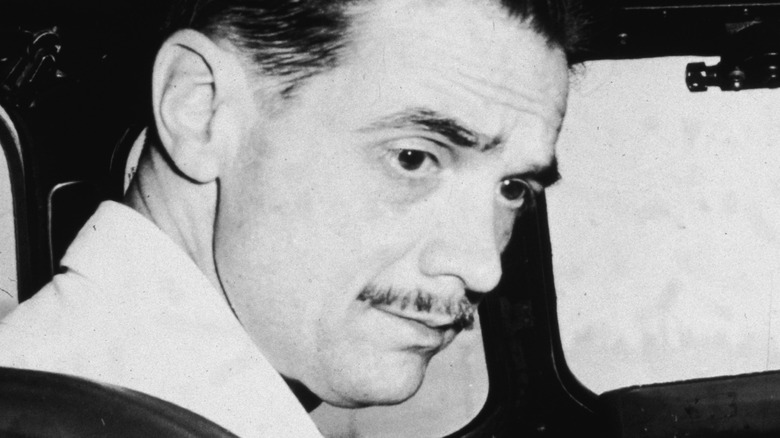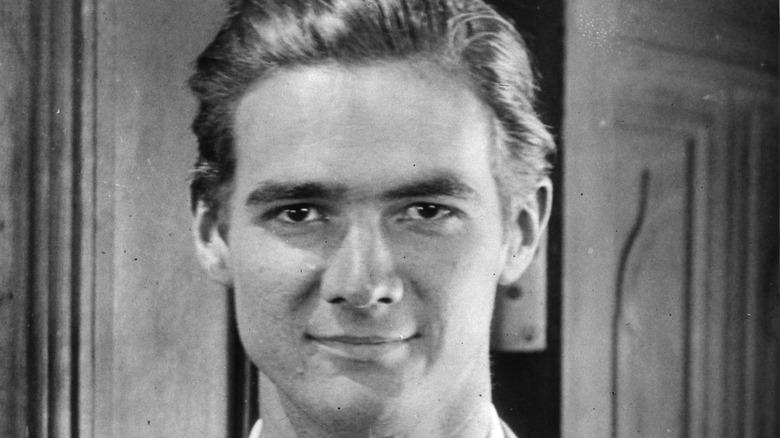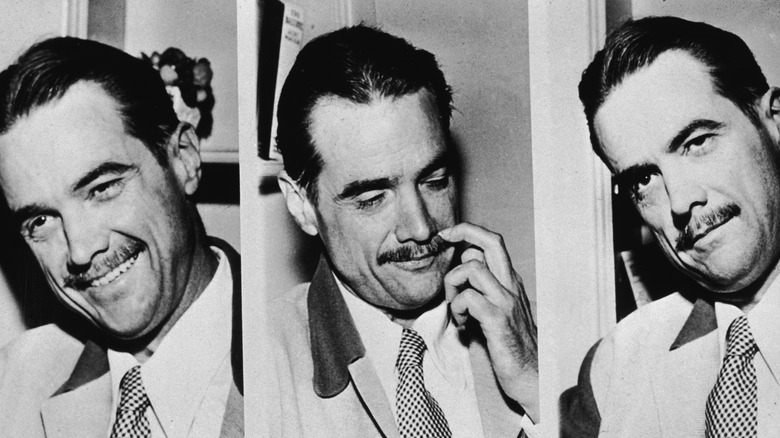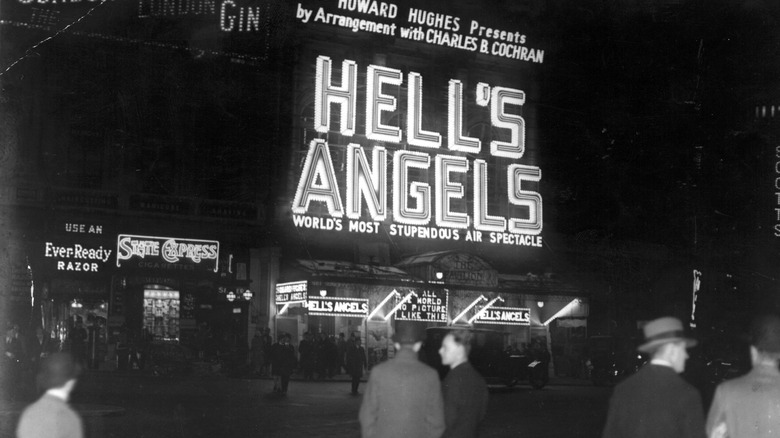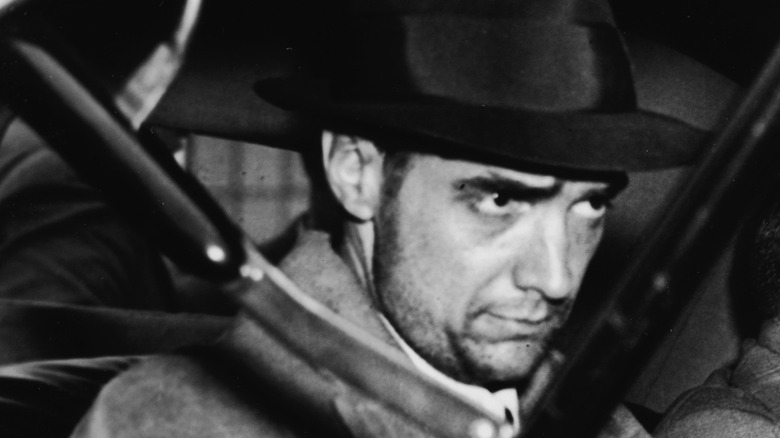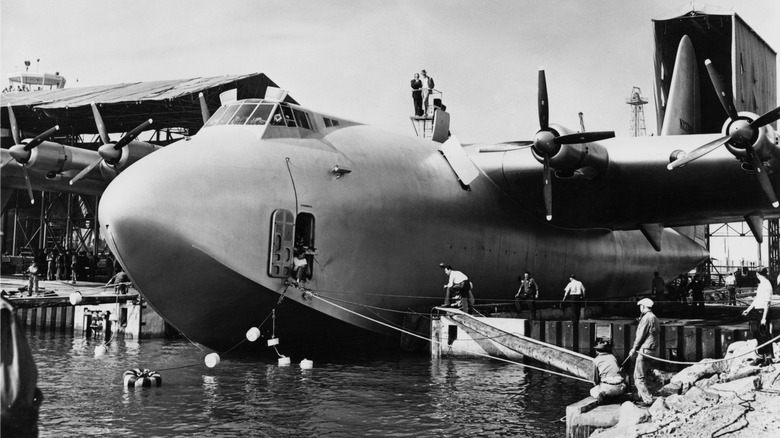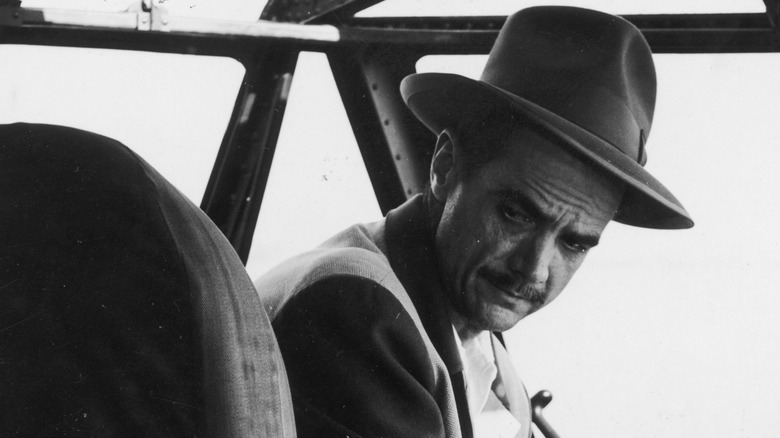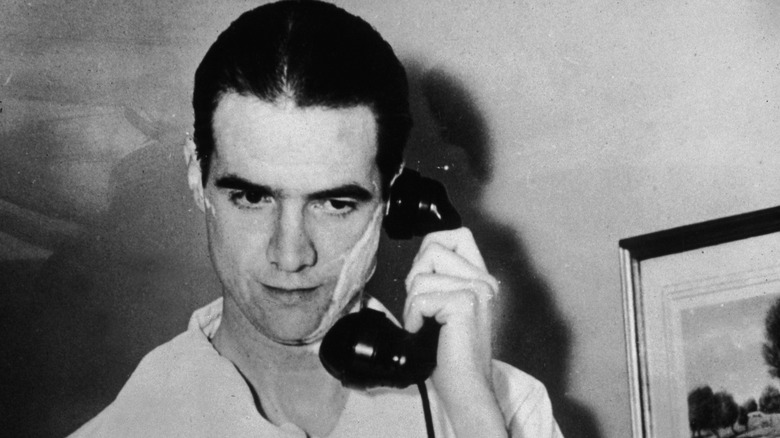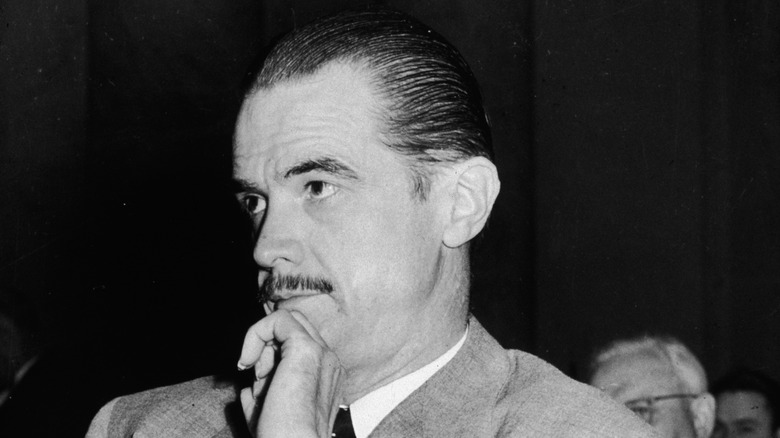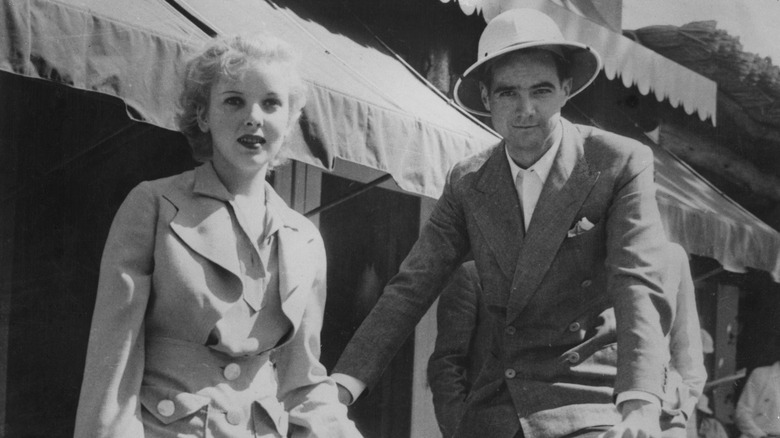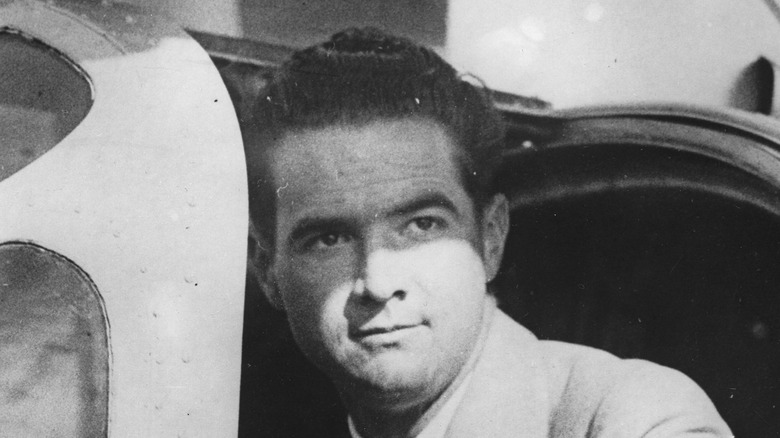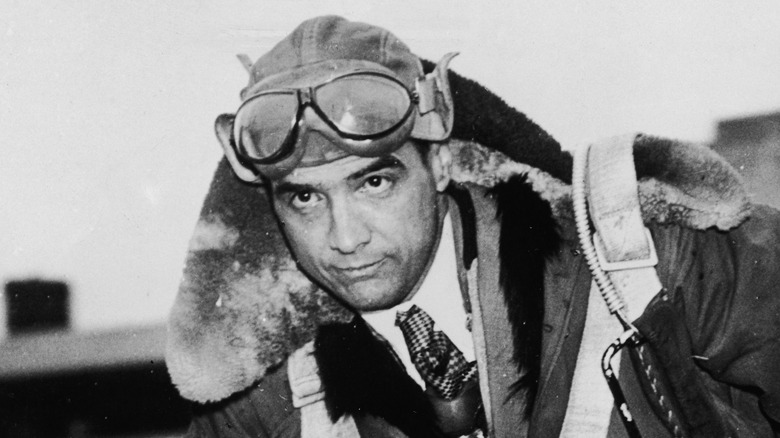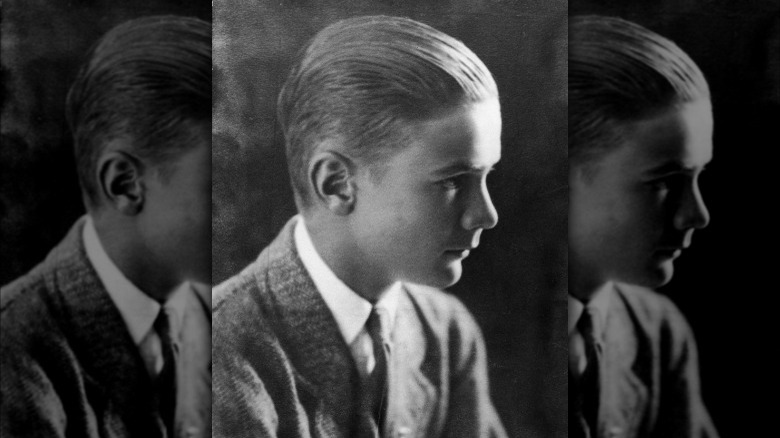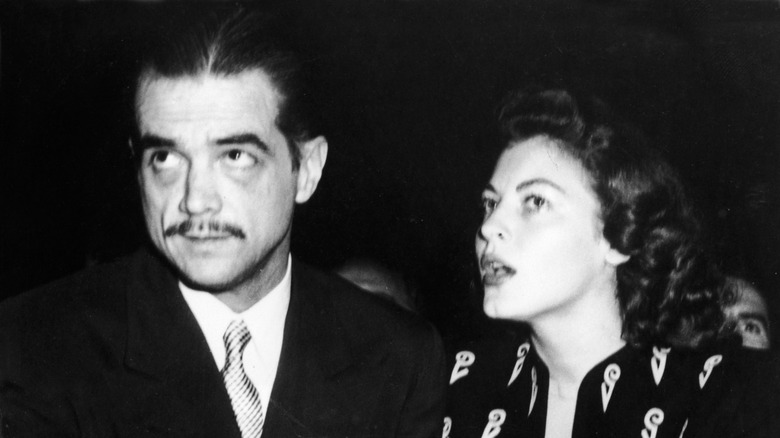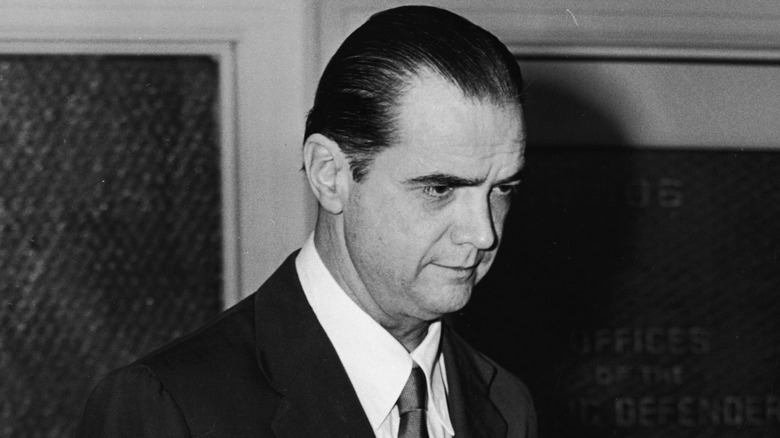The Tragic Real-Life Story Of Howard Hughes
Howard Hughes packed a lot into his 70 years of life. Born into wealth due to his father inventing a rotary bit for oil well drilling that made his small family a large fortune, Hughes inherited the lion's share when both of his parents passed away when he was a teen.
To say Hughes was an ambitious eccentric would be an understatement. Money, as history has proven thus far, has a way of making people go a bit bonkers. And when the person in question is already tipping the scale, as Hughes was, it doesn't take much to push them over the edge.
After his death in 1976, Hughes' estate attorney called for a psychological autopsy and it was determined a lot of the phobias and eccentricities that plagued him during his life could be attributed to his upbringing, and the fact his mother encouraged him to isolate himself and instilled in him her own fears. Troubled though he was, he remains one of the most fascinating characters of his time. Hell, had he known in life his antics would one day be acted out on the big screen by Leonardo DiCaprio, as they were in 2004's "The Aviator," he might have let his freak flag fly even freer.
An orphan at an early age
Howard Hughes' father, Howard R. Hughes, Sr is described by Entrepreneur as an "ex-outlaw oil wildcatter," who made a fortune after inventing a drill bit used in the oil industry, and funneled his earnings into the start of his own business, Hughes Tool Co. His mother, Allene Stone Gano, was "a Dallas debutante, and the aristocratic granddaughter of a Confederate general," according to BBC.
At 16, Hughes lost his mother, whom Peter Harry Brown and Pat Broeske, authors of the book "Howard Hughes: The Untold Story" referred to as "very beautiful and very weird." The cause of her death is most commonly referenced as being due to complications after a minor surgery. Two years later, Hughes' father followed her in death after suffering a massive heart attack, leaving Hughes an orphan, but a very rich one. At just 18, he was the inheritor of an estate worth close to $1 million (in 1924 dollars), according to Entrepreneur, but would not have full access to it until he turned 21.
The biography "Howard Hughes: The Mysterious Billionaire" said that at the time of his father's death he shrugged away all offers of "help" from family members and went to court to have himself declared an adult. Free, capable, and ambitious, he offered chunks of cash to every relative that had a stake in his father's business in order to have primary control. It would be the first of many power moves made by Hughes.
His mother was overly concerned with his health
The name Howard Hughes has become almost synonymous with "eccentric," and most of the man's kookiness and phobias can be traced back to his mother. The biography "Howard Hughes: The Untold Story" claims Hughes had an "emotionally incestuous" relationship with his mother that contributed to what would become his nearly crippling obsessive-compulsive disorder.
A psychological autopsy performed on Hughes after his death determined that Hughes' phobias stemmed from his mother's excessive concerns about germs and obsession over her son's health when he was growing up.
In the book "Howard Hughes: His Life & Madness," it's said Hughes idolized his mother and didn't spend a night away from her until he was 10 years old, while attending a summer camp. His mother, anxious over her son being away from her and worried about his possible exposure to germs, became obsessed with the idea of him contracting polio while at the camp, and wrote several meddling letters to the camp counselors expressing her concerns. The book went on to claim that his mother checked him for diseases every day, and was very careful about what he ate. She is said to have carefully monitored his feet, teeth, and bowel movements, and would take him to the doctor immediately if anything alarmed her.
Howard Hughes was obsessive when it came to cinema
Around 1926, Howard Hughes began to dip his toes into the film industry, and used a nice chunk of his fortune to form R.K.O. Pictures. One of the earliest films he produced, "The Racket," was released in 1928, and was nominated for Outstanding Picture at the 1929 Academy Awards, losing out to "Wings," starring Gary Cooper. This film was thought to be lost, along with two other early Hughes productions: "Two Arabian Knights" and "The Mating Call." However, copies of each were discovered in Hughes' vaults after his death.
Hughes' biggest film endeavor was "Hell's Angels," which cost him big money and big stress. Released in 1930, and directed by Hughes himself, it cost $3.95 million to make (equivalent to approximately $58 million in 2017, according to IMDb). From day one, the making of "Hell's Angels" was trouble. Three pilots died during filming, huge chunks of the film had to be re-shot when cinema made the transition from silent films to "talkies," and the production took three years to complete. Shot in black and white, "Hell's Angels" does feature one "eight-minute two-strip Multicolor sequence," according to IMDb, which is the only surviving color footage of the film's star, Jean Harlow.
Obsessive when it came to cinema, Hughes would often shut himself off from the world for months on end in his private screening room, nude, while eating candy bars and drinking milk, according to Wired.
Hughes killed a man in a 1936 car accident
Howard Hughes' reputation for reclusiveness belies the wild playboy antics he got into as a young man. Well-off youths like Hughes, who go about in fast cars with beautiful women and endless drinks, are often framed either as lovable rogues or entitled and arrogant leeches, depending on one's perspective. But it's all fun and games until someone gets hurt.
On July 11, 1936, according to Darwin Porter's "Howard Hughes: Hell's Angel," Hughes was on the streets of Los Angeles with socialite Nancy Bell Bayly, celebrating her 21st birthday. They were well into the night's festivities when Hughes abruptly came upon an oncoming vehicle. In trying to avoid a collision, he struck a pedestrian, 59-year-old Gabe Meyer, who was killed on the spot.
Hughes, who faced charges of negligent homicide over the accident, was quick to get Bayly off the scene and have his lawyer at the ready. Attorney Neil McCarthy insisted to the press (via the Salt Lake Tribune) that his client was not at fault. Hughes did pass a sobriety test, but McCarthy was at the hospital when it was administered and the admitting doctor — who was convinced Hughes was drunk — was not. Conflicting eyewitness testimony, including a dramatic recant, made the truth impossible to determine. That, and rumored bribes to the DA, were enough to get Hughes off scot-free, to the horror of Meyer's family.
The jumbo plane that could, but didn't
In 1934, at the age of 28, Howard Hughes won his first racing trophy in a custom-modified Boeing 100A biplane. From there, he would go on to form the Hughes Aircraft Company, which he started in hangar space rented from Lockheed according to Spartan College of Aeronautics and Technology, and eventually bought a major airline, TWA, in 1939.
When WWII hit, Hughes became obsessed with creating aircraft for the military and focused on building something capable of transporting troops and supplies across the Atlantic Ocean. The end result of his efforts was the largest wooden airplane ever constructed, the Hughes H-4 Hercules, more commonly known as the Spruce Goose, a nickname Hughes hated. Made out of laminated birch, not spruce, because the use of metals was limited during wartime, Hughes spent $18 million of his own money on the plane, and the United States government coughed up the remaining $22 million. By the time the plane was completed, the war had ended and there was no longer a use for it. The Spruce Goose made one voyage, flown by Hughes, for only one mile, and was never flown again. It's currently maintained as the focal point of the Evergreen Aviation & Space Museum in Oregon.
According to the authors of the book "Howard Hughes: The Untold Story," when Hughes was dying, he told an aide, "I hope I'm remembered for my aviation achievements. I don't want the biographers digging up all the women."
A plane crash may have left him in pain for life
Howard Hughes was no stranger to accidents, either in automobiles or planes (although he seems to have dodged mishaps with trains). Each time, he walked away. But Hughes' luck nearly ran out in July 1946, when he decided to test out the XF-11 reconnaissance aircraft he had designed for the U.S. military. Against government wishes, he flew the test over Los Angeles (per Darwin Porter's "Howard Hughes: Hell's Angel"). The flight got off to an ominous start when the landing gear seemed to malfunction when retracting, but Hughes delighted in the flight, a long-nurtured dream of his.
On his way back to base, Hughes suddenly found the XF-11 pulling to the right beyond his control. A report in the Oxnard Press-Courier described the plane's fiery crash landing, which damaged two homes and destroyed a third. Narrowly rescued by a passing Marine, Hughes had burns, cuts, a broken nose, a broken collar bone, and a collapsed lung. When he was recovered from the wreckage, Hughes looked beyond help, and even after responding well to initial treatment, doctors considered his odds of survival 50-50 at best.
Hughes did survive, but the injuries he sustained in the crash may have changed him forever. Practical Pain Management suggested in 2007 that he was left in intractable pain for the rest of his life. His later addiction to painkillers was a coping mechanism to get by.
Howard Hughes had an intense fear of germs
Perhaps the most widely known bit of info regarding Howard Hughes is he was a severe, almost comical germaphobe. A psychological autopsy performed after his death revealed he went to many unusual lengths to avoid getting sick. Hughes is said to have worn Kleenex boxes on his feet and lay naked in hotel rooms in the dark, which he felt was the perfect way to avoid coming into contact with contaminates. It's also said that if someone who was ill got anywhere near Hughes, he'd burn the clothes he was wearing.
APA CEO Raymond D. Fowler, PhD, the doctor called upon by Hughes' estate attorney to perform the psychological autopsy, went through Hughes' letters, read through articles about him, and interviewed his former staff to complete his report. "A picture gradually emerged of a young child who pretty much was isolated and had no friends, and a man who increasingly became concerned about his own health," Fowler said. During Fowler's interviews with Hughes' former staff he learned that Hughes would make them wash their hands several times and then line them with paper towels when passing him food.
Ironically, towards the end of Hughes' life, he completely let his hygiene go, refusing to bathe or brush his teeth. "He didn't believe germs could come from him, just from the outside," Fowler explained. "He was convinced that he was going to be contaminated from the outside."
His OCD symptoms were so severe he wrote a manual on how to open a can of peaches
The doctor charged with investigating Howard Hughes' mental health following his death, Raymond D. Fowler, PhD, pieced together an upsetting character analysis of a very troubled man. After speaking with employers and associates who were privy to Hughes' daily eccentricities he found his OCD manifested in some severe ways.
In Fowler's report, he detailed that Hughes wrote a manual for his staff on how to open a can of peaches and serve it in a bowl in a very specific way. They were to open the can, remove the label, scrub the can until the bare metal was exposed, wash the can again, and then pour the peaches into a serving bowl, being careful to not allow the can to come in contact with the bowl.
A BBC feature article on Hughes further reveals that he was said to wash his hands repeatedly, so much so they'd begin to bleed. He was also known to obsess over the smallest of details in his film and aviation projects, right down to the kind of bras and underwear his female stars wore. During the filming of the Western film "The Outlaw," it's said that Hughes made a special bra for Jane Russell that was intended to further showcase her already very ample breasts, but she's later quoted as saying that she tricked him into thinking she wore it during filming, knowing he wouldn't be ballsy enough to physically check.
If you or someone you know needs help with mental health, please contact the Crisis Text Line by texting HOME to 741741, call the National Alliance on Mental Illness helpline at 1-800-950-NAMI (6264), or visit the National Institute of Mental Health website.
Howard Hughes was said to be controlling in relationships
Starting with his unusual relationship with his own mother, Howard Hughes' relationships with women were anything but ordinary. According to the biography "Howard Hughes: The Secret Life," his approach at sex wasn't romantic, but seen as either a form of control or relief, like scratching an itch or sneezing. Although he was married twice, and was said to be constantly dating when he wasn't (and sometimes even when he was), Hughes didn't seem to care about forming a true bond with anyone he slept with.
Hughes first married Ella Botts Rice, described as a "Texan society belle" by Karina Longworth, author of the book "Seduction: Sex, Lies, and Stardom in Howard Hughes's Hollywood." In a Washington Post article about the book, it's said the marriage wasn't a love match but more of a way for Hughes to advance his business dealings. After he split with Rice, Hughes went on to marry actress Jean Peters, whom he stayed with for 14 rocky years during which Hughes focused mostly on keeping Peters under his thumb. A Telegraph article on the couple claims Hughes would limit Peters' spending and drinking, and would even hire security detail to follow her around so he knew what she was up to at any minute of the day.
During his prime, Hughes was said to have dated just about every major actress of the time, including Bette Davis, Katharine Hepburn, Ava Gardner, and Rita Hayworth, but he was never lucky in love.
He was diagnosed with neurosyphilis
Howard Hughes was connected to many women over his lifetime, some of whom he knew and romanced. In "Howard Hughes: The Secret Life," controversial biographer Charles Higham claims Hughes had affairs with men as well, although these assertions have faced serious questioning (per the Los Angeles Times). Ultimately, none of Hughes' romances ended in a happy and lasting relationship, and at least one did him lifelong physical harm.
Sometime in the 1930s, per Darwin Porter's "Howard Hughes: Hell's Angel," Hughes contracted syphilis from a sexual partner, which advanced to tertiary syphilis. His treatment of choice, limited in the days before penicillin, involved injections of arsenic and mercury. They didn't work: By 1957, according to Peter H. Brown's "Howard Hughes," doctors had determined his syphilis had advanced to neurosyphilis and caused irreparable damage to Hughes' brain and nervous system. They recommended he be committed to a mental institution, and Hughes' fear his advisors would make such a move pushed him to marry actress Jean Peters that year.
Interestingly, despite Hughes' syphilis being widely reported after his death, his autopsy did not reveal any signs of the disease, or at least none that were reported. Practical Pain Management reported that Hughes' brain and liver appeared normal. In the years since his initial treatment, Hughes had taken courses of penicillin: The journal suggested this would have taken care of his syphilis.
He may have had allodynia
Anyone who suffers an accident as severe as Howard Hughes' 1946 plane crash can expect some measure of chronic pain. But for Hughes, the damage was so extensive he was left with what Practical Pain Management defined as intractable pain, a constant and severe pain that cannot be cured and interferes with daily life. It was such an intense condition that wearing clothing, donning shoes, and brushing his teeth were reportedly agonies to Hughes. Practical Pain Management put forward allodynia as a possible explanation for these issues.
Allodynia (per the Cleveland Clinic) is a neurological condition where mild touch sensations can cause intense pain. It's often caused by illness or medications but can also be set off by physical trauma — like a plane crash. Speaking to The San Bernardino Sun in 2007, Dr. Forest Tennant, who was asked to testify against Hughes' doctors in an investigation after his death, said the pain Hughes endured was so strong that, left untreated, it could have killed him.
For Tennant, this put the treatment used by Hughes's doctors in a new light. "For their time, they did more than anybody could," he said. Practical Pain Management was of a similar mind. They described Hughes's heavy use of painkillers as a pseudoaddiction, a compulsive use of drugs for unmanageable pain.
His hearing gradually deteriorated
Before he was known as a recluse, Howard Hughes was at times seen as shy or distant. This wasn't entirely due to affectations or natural reserve. Hughes was hard of hearing, a condition that worsened throughout his life. According to Peter H. Brown's "Howard Hughes," hearing loss ran in the family. But Hughes and his relatives claimed genetic predisposition wasn't the culprit in this case. A mystery illness in his youth (that may or may not have been real) was named, as was a car accident in Hughes' adolescence. Hughes himself told various stories about his hearing loss. Per Darwin Porter's "Howard Hughes: Hell's Angel," he claimed a guardsman had hit him in the head with his rifle, or that he'd damaged his eardrum while swimming. One of his doctors put the hearing loss down to his work around aircraft, in an interview with People.
While knowledge of how to treat hearing loss was limited in the early 20th century, hearing aids were available, and it was recommended to Hughes more than once that he wear them. But according to Brown, Hughes' pride and vanity wouldn't allow it. Even after being diagnosed with otosclerosis, a bone disease that damages the eardrum, Hughes wouldn't wear aids or learn to read lips. He relied on cars and planes to drown out the persistent ringing that clouded his hearing.
Howard Hughes used codeine for years
When Howard Hughes passed away in 1976 due to kidney failure, it was discovered he had been taking "massive doses of narcotic and pain killing drugs for many years," according to The New York Times. The drugs, said to be illegally obtained, wreaked havoc on his kidneys and allegedly led to his death (although one of Hughes' doctors disputes this, saying his kidney failure was caused by a combination of dehydration and aspirin). In his prime, Hughes was 6 feet, 4 inches tall, and said to have weighed roughly 150 pounds. When he died, he barely tipped the scales at 94 pounds.
An investigation after Hughes' death accused several people on his staff of illegally obtaining drugs for Hughes. His personal physician, Dr. Norman Crane, and an aide named John M. Holmes were accused of "agreeing to use illegal prescriptions written by Dr. Crane to acquire codeine that Mr. Holmes would deliver to Mr. Hughes," according to another article in The New York Times. Both were indicted by a federal grand jury in Las Vegas, with evidence from the Drug Enforcement Administration alleging that Dr. Crane wrote 488 prescriptions under several different names to keep Hughes in a steady supply.Hughes reportedly started taking codeine after he suffered injuries during the crash of a plane he designed in 1946. The drug initially came to him through Emperin Compound No. 4, which also contained the kidney-damaging phenacetin, but he later switched to codeine tablets and then injections.
If you or anyone you know needs help with addiction issues, help is available. Visit the Substance Abuse and Mental Health Services Administration website or contact SAMHSA's National Helpline at 1-800-662-HELP (4357).
He lived in seclusion for quite some time
There's a reason why Time named Howard Hughes one of the top 10 most reclusive celebrities. Towards the end of his life, Hughes' hearing problems, which he struggled with since childhood, and various mental issues caused him to isolate, hiding out for months on end in any one of the number of hotels he owned. In the book "Howard Hughes: The Secret Life," the author, Charles Higham, claimed that, while living at the Beverly Hills Hotel, he became obsessed with flies and would hire people to work 8-hour shifts just to attempt to keep the insects away from him. Hughes would sit in his room naked, sometimes wearing a Kleenex diaper, with Kleenex boxes on his feet, battling flies and fixating on germs.
When not in a hotel, Hughes would shut himself away in his private movie studio and snack on chocolate bars and milk with his hands encased in Kleenex. If all that's not enough to raise an eyebrow, he's also said to have avoided doorknobs, choosing to instead open doors by kicking them, and he avoided the use of germy toilets by urinating on the floor, or into buckets.
